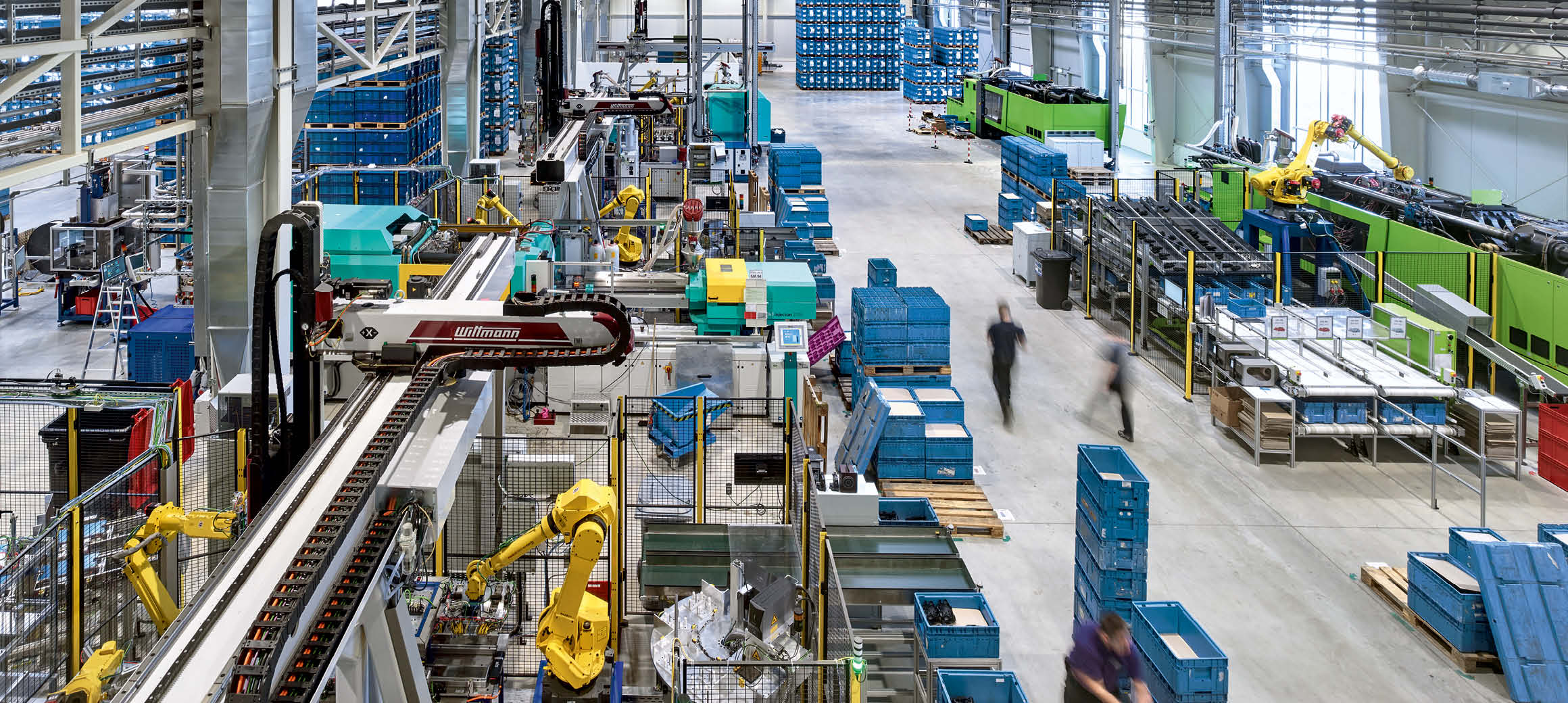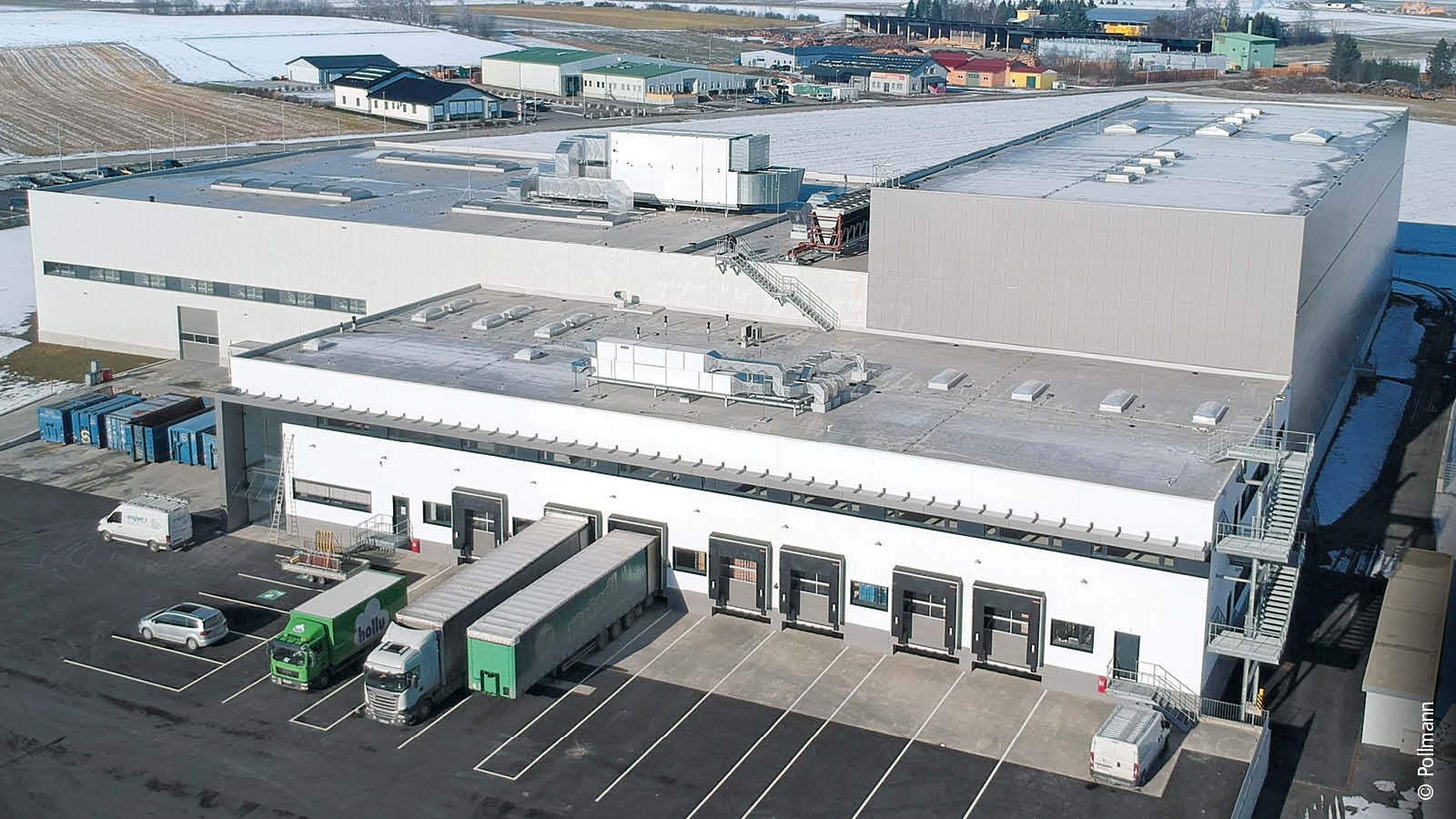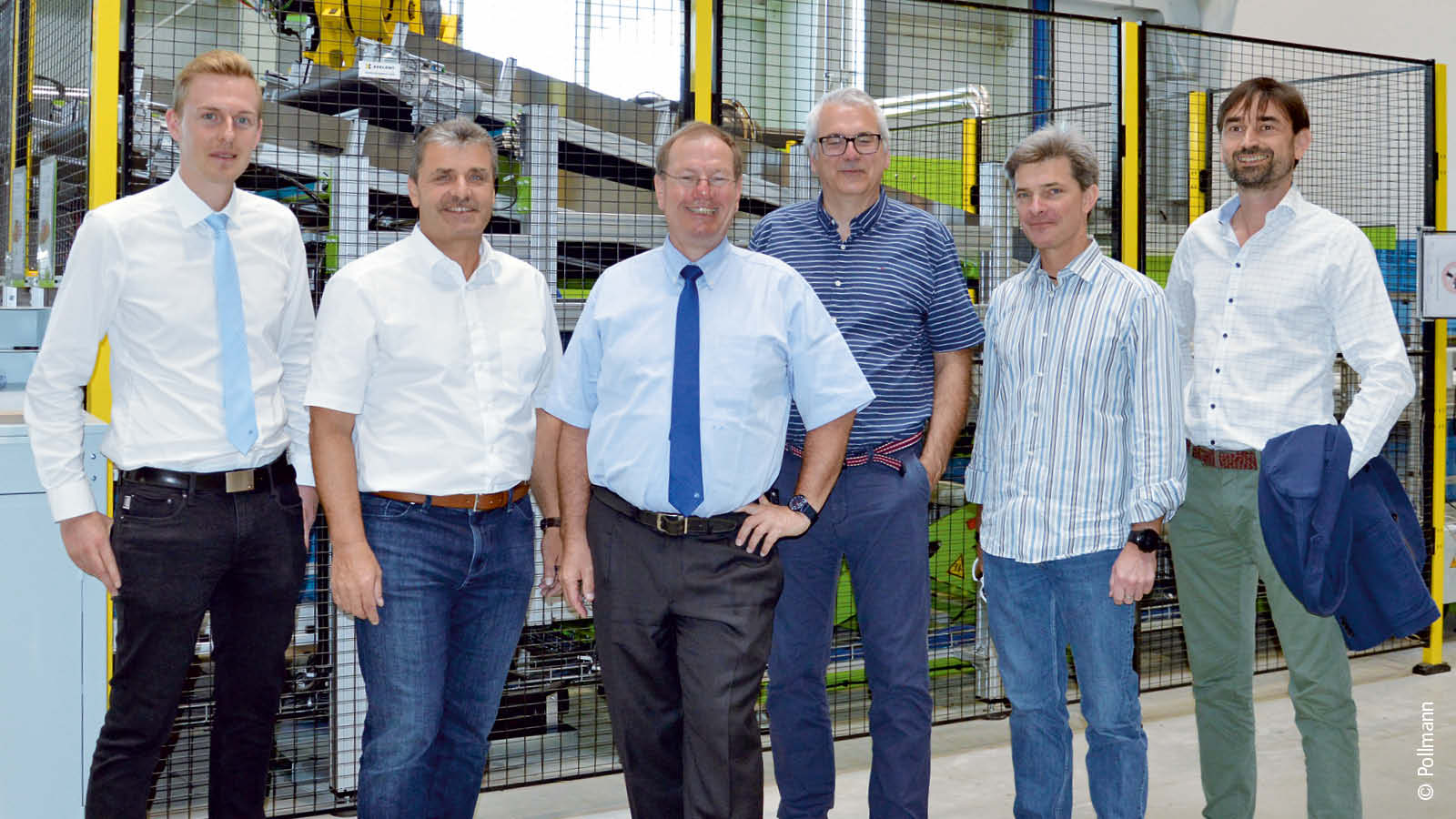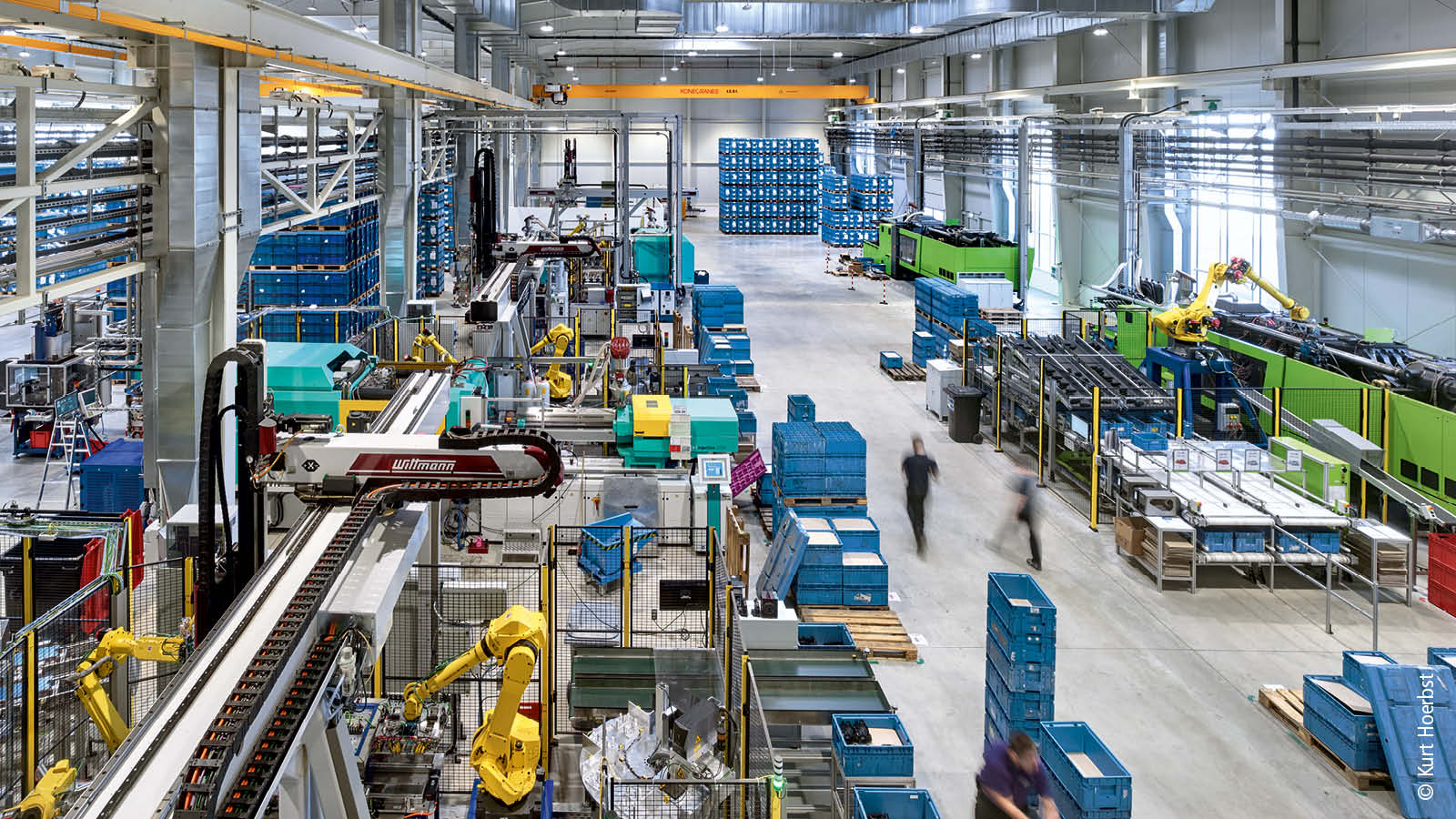

Centrally managed building and production automation with PC-based control
A comprehensive digital twin enabled Pollmann, a global market leader for sunroof kinematics and electromechanical door locks, to virtually design its latest factory in Vitis, Austria. Project designers, installers and the building owner worked closely together and used the projected key figures to run through real-life processes in 3D, make preemptive optimizations and implement all processes consistently using PC-based Control from Beckhoff.
Founded in 1888 by Franz Pollmann, the company started as a craft business for manufacturing precision mechanical instruments and clocks in the Austrian town of Karlstein. More than 130 years later, Pollmann continues to make a name for itself as a developer and manufacturer of innovative products. Today, however, the company’s core expertise lies in highly complex mechatronic components for the automotive industry, and indeed Pollmann is considered the market leader in sunroof kinematics and electromechanical door lock housings. “This is why virtually every car brand in the world relies on our assemblies for its vehicles,” notes Robert Pollmann, the fourth generation of managing partners at Pollmann International GmbH. And so, to handle the steadily increasing demand for the company’s services, the planning and construction of a new plant in Vitis began in 2018/2019. “Pollmann 2.0 is all part of our move toward Industrie 4.0, so we were very clear with all parties involved that we wanted the entire setup to be state of the art. It was essential for us to be able to count on maximum efficiency of the internal logistics and modular expandability of the building as a whole,” explains Robert Pollmann, describing the high demands placed on the project partners Peneder, Stiwa and Beckhoff.

Intelligent networking of mechanical and industrial engineering
In the world of mechanical engineering, it is now common practice to use 3D models for design and simulation. In the architecture and building automation sectors, on the other hand, there are only a few visionary pioneers who are consistently pushing the use of digital twins in the planning and execution of new projects. These trailblazers include Peneder Bau-Elemente GmbH and the Stiwa Group. “As a machine builder and software company, we are used to finding ways to optimize the production environment,” emphasizes Thomas Führer, head of the building automation business unit at Stiwa AMS GmbH. He knows only too well how environmental conditions have a strong impact on the overall effectiveness of a machine: How much space is available around the machine? What are the optimal conditions for a production hall? What about the internal flow of materials and how employees get around? “All of these considerations need to be taken into account when planning a smart industrial building, as do the energy flows,” continues Thomas Führer, pointing out important factors for increasing efficiency.
Since Pollmann only expands capacities if required by incoming customer orders, there was a particularly pressing requirement from the outset in that Plant II in Vitis had to go into full operation no later than 10 months after the groundbreaking ceremony. “The small components, which call for a lot of technology and development work, are still manufactured at the headquarters in Karlstein, but we needed additional manufacturing capacity for the larger components in high volumes, such as housings and covers for door locking systems,” reveals site manager Manfred Jäger. The basic requirements included largely automated production processes with as little logistics effort as possible, sustainable use of energy and all other resources, structured flows of people and goods, and flexible expandability of the production site.
The first expansion stage in Vitis comprises 9,400 m² of production space, a high-rack warehouse with currently 5,500 pallet spaces, as well as offices, technical areas and breakout spaces. That said, the jointly developed master plan is designed in such a way that the plant can be expanded very quickly and easily to up to five halls, which is why all supply lines, as well as material and personnel traffic, were brought together along a central logistical axis. The advantage here is that, in order to initiate the next expansion stage, it is sufficient to extend this main corridor accordingly: “We ourselves would not have thought of a north-south building alignment, nor would we have had the idea of providing for a centrally placed infrastructure channel from which the axes to the individual consumers lead off to the left and right,” admits Robert Pollmann, who is impressed with the foresight of his general contractor.

Designing buildings through an industrial lens
Production-based planning focuses on the manufacturing processes along with all their energy and material flows and all productivity-relevant environmental conditions. “The building is thought of as a machine,” explains Thomas Führer, outlining Peneder and Stiwa’s approach that uses methods and software tools typical of mechanical engineering. In addition to the 3D model of the building, a digital twin was also designed as a Building Information Model (BIM), which allowed proportions, materials, light, shapes and colors to be tested for coherence – just like the planned production and operating processes. BIM is a virtual planning method that combines the respective submodels of the different disciplines – e.g., architecture, logistics, building and electrical engineering, building automation and facility management – into a central 3D model. Peneder, a specialist in industrial and commercial construction, uses BIM at every stage, from planning through to operation. “Virtual planning using BIM has many advantages in the execution and subsequent operation of a building,” confirms Christian Pillwein, Industry Manager Building Automation at Beckhoff Austria.
The closed control loops between production, logistics and building technology alone significantly reduce energy costs. Christian Pillwein cites demand-based ventilation as an example: Intelligent connections between production processes and building and energy supply systems ensure that only as much air is supplied into the hall as is actually necessary due to the machines currently in use. After all, with changeover times or maintenance, the machines are rarely in operation all at the same time. Even in the most textbook companies, overall equipment effectiveness (OEE) averages 75%. “The difference of 25% holds enormous energy-saving potential and can be leveraged very well with demand-oriented building automation control,” shares Thomas Führer. In terms of hardware, the entire control process at Pollmann is based on Beckhoff components. A C69xx control cabinet Industrial PC is used as the control-room server, while the HVAC control center, ventilation and room automation systems are controlled via five CX50xx Embedded PCs. The various sensors and actuators are integrated into PC-based control and TwinCAT using around 700 EtherCAT and Bus Terminals from Beckhoff via subsystems such as KNX, M-Bus and MP-Bus as well as Modbus TCP and RTU.
“The challenge in this project was to develop a needs-based, intelligent control concept that combines manufacturing automation with building automation,” emphasizes Christian Pillwein. Since Pollmann relies on PC-based control from Beckhoff in both areas, combining the technology in this way was a breeze. “Not only can we monitor and control the building services equipment, but we can also record operating data in real time,” explains Thomas Führer, which is music to the ears of Rainer Hobiger, head of facility management at the new Pollmann site: “Our online dashboard allows us to see which machines are running and how well they are doing.” After all, a sudden surge in energy consumption can only mean one of two things: a higher number of units produced or wear and tear on the machines. “Since the quantities can also be tracked, we can send out maintenance personnel as soon as we’ve completed a brief analysis of our target versus our actual performance,” says Rainer Hobiger.

In addition to the load-dependent ventilation, a number of other measures are in place to ensure a sustainable use of energy: The north-south orientation of the building keeps the exposure to solar and therefore the energy requirements for cooling to a minimum. The waste heat from the injection molding systems is used throughout the site for controlling room temperatures, the waste heat from drive cooling is used directly, and that from mold cooling is used indirectly via chillers. Heat is also recovered from both the chillers themselves and the air compressors. “In total, we had to reconcile several temperature circuits used across the technology,” clarifies plant manager Manfred Jäger, explaining why Pollmann was intently looking for what he refers to as a “building automation specialist that sees projects through an industrial lens” for this project.
Buildings that meet industry standards
“For me, hardware is primarily a means to an end to create certain processes and provide benefits in combination with software,” says Thomas Führer. He wants to notice the hardware as little as possible; it should simply work – reliably and around the clock. “Beckhoff’s interesting technology portfolio is based on industry standards and offers the perfect solution for holistic building automation. In this way, PC-based control leaves users completely open in all directions.” In the case of Stiwa, for example, the company now uses Oracle databases that run in the background on the Beckhoff Industrial PCs for analyses or complicated if-then algorithms. Thomas Führer is also a huge fan of the openness when it comes to the field level: “Every field component, regardless of manufacturer, can be integrated into the overall solution via a corresponding interface or bus system.” More than 400 different EtherCAT Terminals contribute to this.
Pollmann was already very well acquainted with Beckhoff before the new building project got underway. “We practically grew up together,” recalls Manfred Jäger, looking back on the first automation technology projects the companies worked on together. “Back then, we had very specific requirements at our production sites and Beckhoff proved to be much more flexible than their competitors,” recounts the head of the production site in Vitis, explaining the switch to PC-based control at that time. Fast-forward to today and Beckhoff controllers no longer simply set the pace for individual machines at Pollmann, but they also govern the central building automation system at Plant II in Vitis.